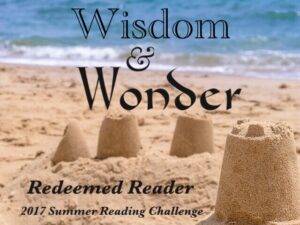 Betsy: It’s hard to believe we’re at the end of our Wisdom & Wonder Summer Reading Challenge! On a personal level, this has been a rewarding study for both my kids and myself. I have been working through the NavPress LifeChange Proverbs study guide we recommended for teens and up, and it has been very convicting—particularly when I realized how many similarities I saw in my own heart with the “simple” and realized how far short of being a true friend I fall sometimes! My children and I had a very interesting discussion on lying and honesty in books and movies. I hope it has benefited you, our faithful readers, in similar ways.
Betsy: It’s hard to believe we’re at the end of our Wisdom & Wonder Summer Reading Challenge! On a personal level, this has been a rewarding study for both my kids and myself. I have been working through the NavPress LifeChange Proverbs study guide we recommended for teens and up, and it has been very convicting—particularly when I realized how many similarities I saw in my own heart with the “simple” and realized how far short of being a true friend I fall sometimes! My children and I had a very interesting discussion on lying and honesty in books and movies. I hope it has benefited you, our faithful readers, in similar ways.
This final week, we turn to love and God’s own sacrificial demonstration of His love for us, his sinful people. As our Redeemed Reader team wraps up with this discussion, I can’t help but think back to our Beauty and the Beast series this past spring. We covered similar topics then, too. So first, we’ll tie these two series together for you!
From the vantage point of Proverbs, when you look back at our Beauty and the Beast discussions, how would you characterize the main characters in terms of wisdom: Belle, Gaston, the Beast, and others? How do they illustrate some of the very things we’ve discussed this summer?
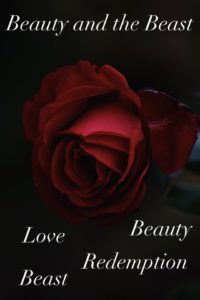 Alysha: Belle certainly had elements of Proverbs wisdom in her character. She was not taken in by Gaston’s flowery words and did not let the jeering townspeople stop her from pursuing her passions. She lived like she wanted to embody Proverbs 3:21-22 “…keep sound wisdom and discretion, and they will be life for your soul and adornment for your neck.” Gaston, on the other hand, is a great example of the “fools” talked about in Proverbs. He struts around town using his good looks to manipulate, bully, and coerce. The Beast is a mixed bag because, at the beginning of the story, he is a vain ruler who only wants to satisfy his own desires. Through the story, he learns to love in a sacrificial manner and becomes a more Biblically wise character.
Alysha: Belle certainly had elements of Proverbs wisdom in her character. She was not taken in by Gaston’s flowery words and did not let the jeering townspeople stop her from pursuing her passions. She lived like she wanted to embody Proverbs 3:21-22 “…keep sound wisdom and discretion, and they will be life for your soul and adornment for your neck.” Gaston, on the other hand, is a great example of the “fools” talked about in Proverbs. He struts around town using his good looks to manipulate, bully, and coerce. The Beast is a mixed bag because, at the beginning of the story, he is a vain ruler who only wants to satisfy his own desires. Through the story, he learns to love in a sacrificial manner and becomes a more Biblically wise character.
Janie: Good answers, Alysha! We shouldn’t forget Cogsworth, Lumiere, and Mrs. Potts, who displayed patience, understanding, and most of all loyalty to their difficult master. Proverbs 14:29 tells us, “A patient man has great understanding,” and in their long service to the Beast they each gained a measure of sympathy for him and a desire to help him. Proverbs 28:20 confirms: “A faithful (loyal) man will abound with blessings . . .” and so these faithful servants were blessed by restoration to their true shapes. I’d like to point out I Peter 2:11-21, encouraging servants to be respectful to their masters—even the difficult ones–in imitation of Christ.
The theme of sacrificial love is one that jumps out in literature, and a character who gives his or her life for another is often referred to as the “Christ figure,” referencing Jesus’s sacrificial love for his wayward people. Which characters come to your mind as crystal clear examples of a “Christ figure”?
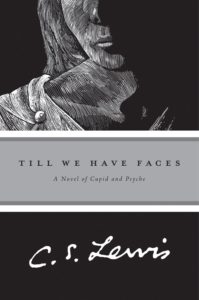 Alysha: Aslan is my first answer. He was written as a Christ figure, and embodies the sacrificial love in a beautiful way. Gandalf from The Lord of the Rings also comes to mind. I believe Harry from the Harry Potter series was meant to embody a Christ-figure, but I have questions as to the successful nature of how that worked out in print.
Alysha: Aslan is my first answer. He was written as a Christ figure, and embodies the sacrificial love in a beautiful way. Gandalf from The Lord of the Rings also comes to mind. I believe Harry from the Harry Potter series was meant to embody a Christ-figure, but I have questions as to the successful nature of how that worked out in print.
Betsy: Alysha, that’s an interesting reference to Harry Potter. I have never thought of him as a Christ figure. There are several characters, though, who choose to lay down their lives for their friends in that series. And, in one of the best character arcs I’ve read, there’s a character who chose to live a remarkably sacrificial role–all the more because no one knew he was fulfilling that service and reviled him instead. I won’t give any spoilers here, but there are some marked examples of this sort of sacrificial love in the (dark) later Harry Potter books.
Megan: I always think of Psyche in Till We Have Faces, who visited the people in the midst of the plague and, to Orual’s horror, took their filthiness upon herself. Then she was doomed to be sacrificed to the god of the mountain on behalf of the people so blessing would be restored to them.
Janie: There are so many! One unusual Christ figure is in North to Freedom: a scruffy muff who follows the protagonist for part of his journey (to the boy’s disgust) but ends up saving the boy’s life at the cost of his own.
Hayley: Like Alysha, I go right to Narnia. I also think of a trilogy I read when I was much younger, Tales of the Kingdom by David and Karen Mains. It’s a beautiful allegory with a very definite Christ figure. I remember how excited I was when I first realized the symbolism of that figure in the series!
Betsy: Some great examples here, ladies! Love and generosity go hand-in-hand even though we aren’t all called on to give our very lives for those we love. Unfortunately, our society sometimes twists this biblical idea and implies that romantic love can demand unbiblical “gifts” as “proof” of love. A biblical, generous love isn’t motivated by proving its love or earning someone’s love in return; rather, biblical love is motivated by the other’s best interests and spurring him or her on to be more like Christ.
Can you think of particular books or movies that show a healthy, biblical picture of generous love—romantically or within the context of family or friendship?
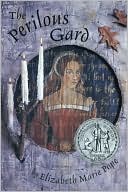 Alysha: Two examples come to my mind: The Princess Academy by Shannon Hale, and The Tale of Despereaux by Kate DiCamillo. In The Princess Academy, Miri, the protagonist, learns to reach outside herself and love others with a selfless, generous love. She is able to bind the girls of the Academy together to overcome several obstacles. Her approach to family and friendship is a beautiful example of Biblical love for friends. The Tale of Despereaux sees a young mouse fall “in love” with a Princess. He is even willing to face the darkness of a dungeon full of rats in order to be her friend. His character shows that friendships need to be mutual, and that we should all fight for the good friends we have.
Alysha: Two examples come to my mind: The Princess Academy by Shannon Hale, and The Tale of Despereaux by Kate DiCamillo. In The Princess Academy, Miri, the protagonist, learns to reach outside herself and love others with a selfless, generous love. She is able to bind the girls of the Academy together to overcome several obstacles. Her approach to family and friendship is a beautiful example of Biblical love for friends. The Tale of Despereaux sees a young mouse fall “in love” with a Princess. He is even willing to face the darkness of a dungeon full of rats in order to be her friend. His character shows that friendships need to be mutual, and that we should all fight for the good friends we have.
Megan: Excellent examples, Alysha! I would also add Mrs. Frisby and the Rats of NIMH. Numerous characters in that book shine with selfless acts: Mother for child, husband for wife, friend for friend, friend for the memory of friend. I cried at the end, it was so beautiful!
Janie: One of my favorite examples is The Perilous Gard, in which a young woman risks her life in the shadow world to redeem the man she loves from the stern justice of paganism. It’s not just an example of sacrificial love, but also a picture of Christ redeeming us from the demands of a law we can’t keep.
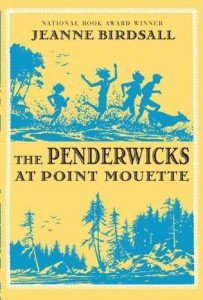 Hayley: When it comes to love within the context of family, I think of the Penderwicks. I love how the Penderwick family operates and how the siblings care and are fiercely loyal to each other, while still being typical siblings who aren’t above annoying each other! And then, I have to bring up Megan Whalen Turner’s series. Though we see romantic love between some characters, there are so many examples of love in the purely platonic category. Love between friends, between comrades, between a teacher and his pupil. And it’s captured without the sometimes icky twists that modern authors like to add.
Hayley: When it comes to love within the context of family, I think of the Penderwicks. I love how the Penderwick family operates and how the siblings care and are fiercely loyal to each other, while still being typical siblings who aren’t above annoying each other! And then, I have to bring up Megan Whalen Turner’s series. Though we see romantic love between some characters, there are so many examples of love in the purely platonic category. Love between friends, between comrades, between a teacher and his pupil. And it’s captured without the sometimes icky twists that modern authors like to add.
Betsy: Those are fantastic examples, all of them! I’ll add the tremendous example of Samwise Gamgee and his love for and service to Frodo–going so far as to carry Frodo himself because he couldn’t take the ring itself as a burden. In our anchor books this week, I think of Aidan’s and Dobro’s friendship in the Wilderking books, clearly modeled after David and Jonathan in the Bible. They accept each other for who they are in their respective cultures and love and serve one another as they can. The siblings in The Wingfeather Saga are a good picture of loving one another, too.
For romantic love, I love the characters of Frank and Dottie in the 100 Cupboards books. The Wingfeather Saga also features love between parents, although the parents are loving one another in absentia (in a sense). In fact, I think it’s more likely to find good examples of a healthy, romantic love in the married parents that appear in many kids’ books than that of a teen romance!
And, finally, is there one book, movie, or series that came to your mind more than any other this summer as we unpacked these themes of Proverbs? I know for me (Betsy), the Narnia Chronicles kept coming to mind as illustrations for the different sub-themes.
Alysha: Madeleine L’Engle’s Wrinkle in Time Quartet came to my mind more than once.
Megan: Pilgrim’s Progress.
Hayley: Narnia and Megan Whalen Turner’s books.
There you have it! Our final “discussion” of the themes of Wisdom & Wonder. It’s been a rich study, and we hope you’ve enjoyed it. We also hope you’ve started looking for the themes of wisdom and wonder (and the related sub-themes) in the books you read. Thankfully, there are many good examples out there!
Stay tuned for our giveaway announcement next week! In the meantime, what was your favorite book this summer?
Support our writers and help keep Redeemed Reader ad-free by joining the Redeemed Reader Fellowship.
Stay Up to Date!
Get the information you need to make wise choices about books for your children and teens.
Our weekly newsletter includes our latest reviews, related links from around the web, a featured book list, book trivia, and more. We never sell your information. You may unsubscribe at any time.
We'd love to hear from you!
Our comments are now limited to our members (both Silver and Golden Key). Members, you just need to log in with your normal log-in credentials!
Not a member yet? You can join the Silver Key ($2.99/month) for a free 2-week trial. Cancel at any time. Find out more about membership here.
2 Comments
Leave a Comment
You must be logged in to post a comment.


I truly don’t understand the positive reviews of Tale of Desperaux. It’s depictions of physical abuse and neglect are seriously troublesome in a children’s book. I read all the way through hoping there would be a positive spin or lesson to be learned but there was none. The character is taken advantage of till the end. And attempt at biblical themes was erased for me with the poor choice to include abuse without a satisfactory resolution.
You know, we can never know what an author intends (unless they come right out and tell us–which is rare!). But the imagery of light and dark in this tale is striking, and Despereaux’s search for the light arguably mirrors our own need to search for the light of Christ. I realize that’s very big picture, and many young readers of this book won’t naturally gravitate to those words. But I can also tell you that this very book–particularly the ideas of light v dark in it–is one of the feature articles in our upcoming Redeemed Reader Quarterly! I’m not able to reprint the entire article here, but perhaps thinking on this juxtaposition of light and dark will help explain why so many enjoy this book? DiCamillo never shies away from hard situations in her book, true, but she does often point readers to a “something beyond,” which we appreciate. Try The Miraculous Journey of Edward Tulane, perhaps, for a DiCamillo story that is just lovely.